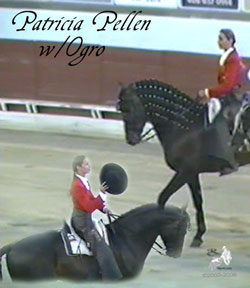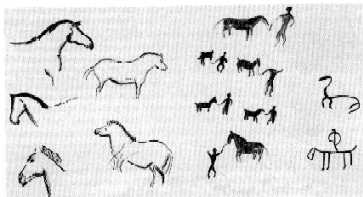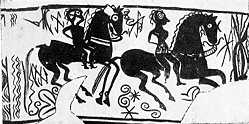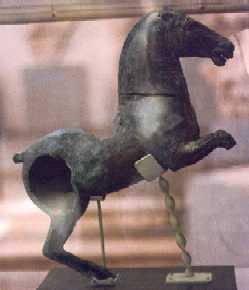
The History of the Andalusian
Horse
The Ancient Breed
The Andalusian Horse is one of the ancient breeds of the world.
Its origin in the Iberian Peninsula is documented by cave paintings
and even fossil evidence. That horse domestication began very
early in the region that is now Spain, Portugal and southern
France is evident form ancient sources. These include cave drawings
which are dated as being more than 20,000 years old and fossil
skulls of horses showing the peculiar wear of the front teeth
found in horses which crib (chew and grind at their enclosures)
a nervous vice known only to exist in captive, confined horses.

Top: Paleolithic drawings from the Iberian Peninsula
show the two types of horses found at that time, The Proto Iberian
with a more subconvex profile and the Iberian Pony with a more
convex profile.
Bottom: Neolithic Iberian man with domesticated horses.
Many ancient peoples knew of the horse of the Iberians and praised
them in writings, drawings and sculpture. The Greeks and Romans
many times refer to the Iberian Celts as superb horsemen and
their horses as exceptional.

Iberian
Celt Horsemen from a 4th century BC vase
|
Xenophon, considered by most as the founder of
classical equitation, wrote of the Iberian horses that they had
the ability to gather the hind legs under the fore, falling back
on their hocks and raising the forehand, so that the belly can
be seen from the front. This ability, which we now call collection,
was impressive in that it allowed warhorses to be swift and agile
and to stop and turn quickly in any direction. The Iberian horses
and their riders undoubtedly gave Xenophon his first glimpse
of classical riding. Iberian cavalry was one of the most important
weapons of generals from Hannibal to Julius Caesar. The Iberian
horse both shaped the way mounted warfare was conducted and was
shaped by it. Its speed, agility and courage were unequaled and
lent themselves to the mastery of mounted fighting. The Romans
were so impressed by the Iberian Celts that after meeting them
in battle they adopted both their weapons and fighting style
and set up remount breeding stations for their legions in Baetica
(modern Andalucia) to take advantage of the fine horses to be
found there. There is also mention of mares brought from the
Tagus valley region (Portugal) who were described by Pliny the
Elder, a Roman cavalry officer and writer, as “fine, docile
and impregnated by the west wind, (which) brought forth offspring
of surprising fleetness.”
 |
Roman Era Bronze from Merida (Capitol of Roman
age Lusitania) showing the classic round conformation of
the Andalusian horse in a characteristic pose that shows
the ability to lift the forelegs through natural collection
that made it so prized by the Romans and Greeks and inspired
Xenophon to invent the beginnings of classical dressage. |
The Roman cavalry used the natural agility, flexibility,
collection and willingness of the Iberian horses to great advantage.
The horses were presented in battle formation, tightly ranked
together, in shoulder-in position with shields to the fore. This
allowed the shield to protect both horse and rider, presenting
little to an opposing enemy to hit while allowing the rider’s
lance or javelin to be used effectively. These horses were also
able to perform the spectacular movements of defense and offense
we now call the “Airs Above the Ground.”
|


